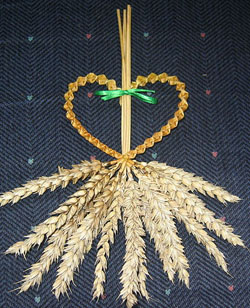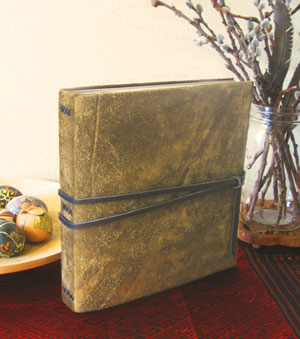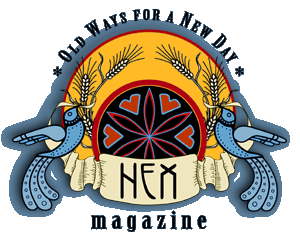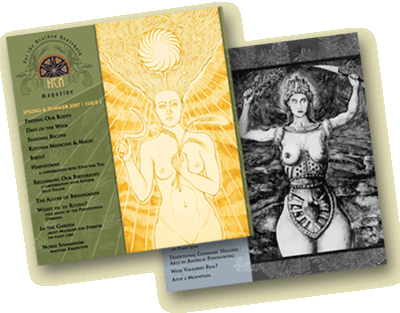~ THE TURNING OF THE WHEEL ~
FEAST OF BREAD 2009
Announcing pre-sales for Issue #5!
Bands on the compilation CD include:
Allerseelen • Andrew King • At the Head of the Woods • Beastianity • Hamramr • Irij • Ironwood • Ruhr Hunter • Sangre Cavallum • Sieben • Steve von Till • Svarrogh • Waldteufel • Wardruna
Hex needs your help! This is a community-supported not-for-profit publication. You can support us by clicking the image above and ordering magazines and prints, and spreading the word to all like-minded folk!
* * * * * *
Stella Natura: Reaping the Flesh of Light
Hex will have a trade booth at this amazing festival! Come join us!
September 25th and 26th, MMIX
Nevada City, CA
* * * * * *

 Corn “Dolly”
Corn “Dolly”
.: Harvest Season :.
For the Heathen Hearth, the harvest season began around the first full moon in August, if everything went as planned. Old world Heathens had high hopes that all their hard work, charms, and offerings to the wights would yield a good harvest.
Good harvests were nice, but larger harvests allowed a cushion for the family – because occasionally the crops failed. Natural forces in the Northlands can wreak havoc pretty fast on tender crops. If something went wrong and harvests failed, stored grains would hopefully be available.
Today crop failures don’t seem to have much of an effect on the average family. However, climates around the world seem to be changing in unpredictable ways. While economic problems leave less money for farmers to produce their crops causing them to produce less.
One of the worlds leading experts on agricultural commodities, Don Coxe, noted in June of 2009 that “…the next global food shortage promises to be both pronounced and prolonged.” [ http://www.commodityonline.com ]
Early this year crop failure visited our kitchen garden, we received more than two weeks of daily heavy rains that saturated the ground. After the first week of rain we could see noticeable wilting of the vegetable plants we’d set out. By the second week the plants were dead and turning black – completely drowned. My mind went to thoughts of what a disaster my disir would have found such circumstances.
Once the garden dried up we replanted. After a few weeks we noticed the wildly blooming tomatoes weren’t producing fruits. Soon I found out why, while watching a local university sponsored gardening program on PBS I found out that others were experiencing similar problems. Then I learned that if your vegetables and fruit were not setting fruit, it was just possible that either you or one of your neighbors have accidentally killed off the local honey bee population!
Sure enough when I looked the next day the only bees I saw around the garden were a few carpenter bees. These big bees live in the wooden foundation of the shed and only seemed interested in the wild Virginia Meadow Beauty that always grows around the edge of the garden fence. They seemed to have no interest in the garden plants.
In some areas in China the honey bees have disappeared completely. Today they must hand pollinate nearly everything, including acres and acres of fruit groves which are their livelihood. I decided to hand pollinate the tomatoes. Now small green globes are beginning to show under their blossom, finally, further proof of the loss of my neighborhood’s little mead companions.
Insecticides are often the culprit in bee kill offs, if you need to use one of these products be sure to read the label thoroughly. When you apply it make sure you do it very early, before the honey bees arrive, or in the evening after they’ve gone in for the night. Educate your neighbors when you get a chance so they don’t kill off the honey bees either.
In the meantime, like Heathens of old, we should be prepared for those times when the harvest isn’t what we’d expect it to be, either our own or at a more global level. Learn a lesson from those early Heathens and be sure and keep a store of staple foods tucked away. Decide where such staples can be stored in the home, make sure it will be in a protective container and be sure to rotate your stock. Many web sites and books can help you decide what your family should have “squirreled” away. Check out the Federal Emergency Management Agencies booklet here – http://www.fema.gov/pdf/library/f&web.pdf
Last but not least with so many dangers that can threaten the harvest don’t forget to make a corn dolly for your garden or hearth to entice the spirit of the corn (grain) to stay.
~ Hedgewife Teresa Luedke
* * * * * *
The loss of our honey bees is an epic tragedy on the global level! Translate: NO BEES NO FOOD. Please educate yourself. Here’s some helpful places to start:
Hard science looks at what that goes into genetically modified corn and which they figure is killing the bees: www.organicconsumers.org/articles/article_16249.cfm
Here is a really solid article on this chemical, which is actually produced by Bayer – but one of the main crops it is put on is, you guessed, it GM corn! Enter Monsanto, who in this case might not be the primary culprit though obviously involved:
www.viewzone.com/lostbees.bayer.html
And here is a great quote:
“Genetically modified (GM) plants account for about 40 percent of U.S. cornfields. A small study done at the University of Jena in Germany found that pollen from GM corn made the bees more vulnerable to death as a result of carrying the varroa mite. The bacterial toxin in the corn appeared to alter the surface of the bees’ intestines, weakening it enough to allow the parasites to gain entry.”
http://www.odemagazine.com/doc/50/give-bees-a-chance
More about GM corn and why we shouldn’t eat it or any of the huge percentage of processed food that is filled with it: In Defense of Food by Michael Pollan www.michaelpollan.com
~ Hex staff
* * * * * *
Nourishing An Evolving Species
or, Why I Drastically Changed What I Eat
After Becoming A Mother
I became a vegetarian at age 12 and never looked back, eventually sailing through my pregnancy and very early post-partum days beautifully on a mostly vegan diet consisting largely of processed foods. But soon after Mycelia was born and our constant-breastfeeding relationship was established, my health took a turn for the worse. As if being a new mama isn’t challenging enough, I was feeling weaker, more exhausted, and less mentally capable than I ever had in my life. (A breastfeeding mom burns between 300 and 1,000 calories A DAY just sitting in a chair nursing! And aside from all the caloric output, the baby is also literally sucking out all available nutrients from the mother’s body). Somehow I trudged through the days, thinking of my life more as a game (though not a fun one) of survival than anything else.
At about 8 months postpartum a number of people began to mention the philosophy of Traditional Foods to me (check out www.westonaprice.org). It immediately made sense to both Graham (a long time vegan and vegan chef) & I and, though we were trepidatious at first, we quickly incorporated more traditional foods into our diet, including some animal protein and lots of animal fat.
Both of us feel better now than we ever have, and noticed a definite positive change in Mycelia’s mood and behavior soon after she started getting more nutrients through my milk and in her own food as well. The philosophy is too multi-faceted to go into here, but I will share the two main concepts that appealed to us enough to undertake such a monumental change.
The first is the simple concept upon which the more complex system is based: nutrient density. When seeking food to nourish our bodies, we should choose those that have the highest amount of nutrients per calorie. (Bone broth, a food found in every traditional culture in the world, is a good example, and it is, I swear, what has kept our family illness-free this last winter).
The other is a concept, a factual concept for that matter, which has guided many of the decisions Graham and I have made together since becoming a couple and starting a family: Physiologically, we humans are the same creatures we were in the Pleistocene Era, back when we were hunter/gatherers. Though our minds and our cultures have evolved exponentially in the tens of thousands of years since then, our bodies have had very little evolutionary time to become anything new. So attending to our health and reproduction in the same way that our ancestors did gives us the best shot
at a healthy life.
We applied this principle when we chose to birth naturally and let the intricate hormonal interplay that takes place between mother and baby during labor unfold unhindered, when we chose to breastfeed and give our daughter the perfect food that has evolved through millions of years to nourish her completely, when we chose to keep her near our bodies night and day, and when we chose to treat our illnesses with time-tested and powerfully effective plants instead of synthetic chemicals. So choosing to eat the foods that have sustained human beings from all regions of the globe beautifully for millennia was a no-brainer.
~ Amber Hill
www.NourishedMother.com
www.VioletFolklore.TypePad.com
Further Reading:
· http://www.westonaprice.org/childrens-health/1914-modernizing-your-diet-with-traditional-foods.html
· www.washingtonpost.com/wp-dyn/content/article/2009/07/02/AR2009070203365.html?nav=rss_email/components
· www.health.msn.com/nutrition/articlepage.aspx?cp-documentid=100241585&ucpg=1#uc2Lst
Here’s a great article about different groups organizing and trading food in cities around the country…it talks about all sorts of models.
www.nytimes.com/2009/06/10/dining/10Fruit.html?_r=4&pagewanted=1
Here is a section that mentions Portland, but the entire article is worth reading.
“Three years ago, Katy Kolker had a similar experience in her northeast Portland, Ore., neighborhood. Fruit was going to waste, and she decided to do something about it.
She and some friends went to the home of a woman who had planted apple trees 30 years before, but was too old to pick them. They gathered nearly 200 pounds, gave some to the woman and went back to prune her trees.
That apple adventure inspired the Portland Fruit Tree Project, a database of more than 300 trees, each registered by the owner, who promises to call about two weeks before the fruit is ripe to arrange a harvest.
“A family can only really eat 20 pounds of fresh apples or so before they cry uncle,” Ms. Kolker said. “A fruit tree is really made for sharing with your neighborhood.”
This year, 20 picking parties are planned. Half the fruit goes to the people who pick, and half to a local food bank. Ms. Kolker reserves half of the dozen slots at each picking party for low-income people.”
~ Hex Staff
* * * * * *

• GEBO •
Old English Rune Poem
Gyfu (Gift) for men is adornment and complement,
support and dignity; and for all the dispossessed
forgiveness and sustenance, who would otherwise
have nothing.
~ Rune poem translations by Sweyn Plowright
http://www.mackaos.com.au/Rune-Net/Primer/
Loaf Feast was celebrated with the arrival of the first fruits of the harvest each year. In return for care, attention, patience and work the land and elements offered their first gifts to our agricultural ancestors – and still do today of course!
This seems to be an invitation for us to reflect on our endless cyclic debts and loans – not the punitive and off-kilter economy of fraudulent (or at least immoral) housing loans, but rather the healthy, breathing exchange of obligations that our whole existence depends on.
An essential facet of Heathenism – in my humble opinion – is the acknowledgement of how interdependent all things are. No individual person could survive – let along thrive – in isolation. Only in the circulating, dynamic stability of community can each of us find our place. Even when we feel the need to reject others, to find isolation, even this need can make sense only on the horizon of our deeply communal character.
Likewise, each community depends on both other communities and on the natural world for sustenance, clothes, news, novelty, hopes and the pleasures of work and play. Without the earth, the clouds, the trees, the sun, the moon – nothing would be possible and we would have never have been. Similarly, trade was an important facet of historical Heathenism – the culture of the Dark Age Scandinavia is particularly well known for its vast and free-wheeling trading habit.
Of course we do not only receive bounty from our relationships, sustain us though they do. Disruption, loss, disappointment and misdirection can also emerge from our deep interdependence with all around us. It might be tempting to bury our heads in the ground in the face of our Gebo-given vulnerability, to curse the bountiful but sometimes fickle fashion. There’s a place for that, but no need to fall into despair!
Just as the bareness of winter is a natural part of the seasonal cycle that ultimately delivers the Loaf Feast to our door, so too all ordeals and struggles might yet become the harbingers of new fertility and wealth. You just cannot know – and after all, who would think that tossing a bunch of seeds into the ground would in time yield nourishing food?
Gebo is not just a symbol of good fortune, love or the interwoven nature of all things. It is a reminder to us that wyrd is richer and thicker with possibility than our common sense might like us to think; and that we can draw courage from this cyclic exchange.
Friendship at its best can be a powerful tool for our transformation, growth and deepening: “[a] friendship, a family, a community, a church, a club, a conversation, a diary, a dinner, a walk with someone – these can all serve as vessels for the stuff that plagues you.” (Thomas Moore) This to me is one of the most profound secrets of Gebo’s lore.
We can never understand all the mysteries of exchange, mutuality, indeed, the vast, rich weave of wyrd. Nevertheless, we can choose to put aside our armoured, limited expectations and instead embrace this Gift, this mystery of “forgiveness and sustenance.”
I have a feeling that the more we manage to do this, the more nourished and free we will become. We’ll discover that our interdependent vulnerability is also the seat of our power.
* * * * * *

*Esoteric Book Conference 2009*
September 19 & 20 Seattle Center
[http://www.esotericbookconference.com]
* * * * * *
: 2 left! :

Limited Edition Leatherbound Hex Collection
This complete collection of all four issues of Hex magazine, is beautifully bound in leather by Jason H. Craban. Each magazine is stitched with linen into the spine of this sturdy and handsome handmade case. The binding lays flat for ease of reading, and is held closed by a leather strap. The edition is limited to 13, all numbered, and signed by the artisan and editors of Hex. It features the first two issues which are now out-of-print and unavailable as well as the third and fourth issues which are nearly sold out as well.
IF YOU WANT TO PURCHASE A COPY
REPLY TO arrowyn@hexmagazine.com WITH YOUR ORDER.First come, first serve!
If you are one of the lucky ones, when your email is received, you will be notified, and sent an invoice through PayPal to complete the purchase of your copy.
Each leatherbound copy is $100 + shipping
All proceeds go to Hex Press to support its continued effort to provide folks with an excellent volunteer-based, community-supported, not-for-profit publication.
: 8 left of each! :
Limited Run of Issues 1 and 2
order at:
www.hexmagazine.com/subscribe.htm
* * * * * *
Until the Autumn Equinox, may you and your
household be blessed and kept. Hail!
~ HEX Magazine
* * * * * *












Leave a Reply